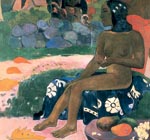From Russia: French and Russian Master Paintings
Be exhilarated by a collection of Russian and French masterpieces finally on show at the Royal Academy, says Rose Baring


After weeks of political tension, and a serious threat of cancellation, the walls of the Royal Academy are now dancing to the rhythms of the controversial exhibition that brings together French masterpieces collected by Russians at the turn of the 20th century with the exhilarating works of contemporary Russian painters. Following on from the 2004 show 'Russian Landscape in the Age of Tolstoy' at the National Gallery, it gives London art lovers a chance to see how the avant garde exploded onto the Russian art scene in the decades leading up to the revolution. It is also a celebration of courageous collecting the story of how these vibrant French Impressionist, Post-Impressionist and Cubist works got to Russia, and the influence they had on Russian and, subsequently, European art history. 'From Russia' acknowledges the collecting genius of men such as Pavel Tretyakov, Ivan Morosov and Sergei Shchukin, who amassed industrial fortunes in the second half of the 19th century and used them to back painting that was, at the time, every bit as radical as the work of the post-war Abstract Expressionists or the Young British Artists.
There's a delicious symmetry in showing this tribute to the fabulous collecting power of the Russians when collecting is once again all the rage among Russia's new rich. At the time of the Russian Revolution in 1917, the greatest collection of French contemporary painting anywhere hung in the private Moscow house of Sergei Shchukin. A stuttering industrialist from a traditionally hidebound mercantile background, Shchukin began his collection with a
Monet in 1897. By 1914, it had swelled to include eight Cézannes, 16 Gauguins (all hung on one wall), 39 Matisses, 13 Monets and 51 Picassos.
His advice to his daughter ran thus: 'If a picture gives you a psychological shock, buy it. It's a good one.' He was one of the most important early patrons of both Matisse and Picasso, buying their work when French critics were still describing them as 'lunatics' and 'monkeys' who 'should be sent back to school'. It was Shchukin who commissioned the massive canvas The Dance from Henri Matisse, which has been lent by the Hermitage Museum. Along with Music, of similar dimensions, it was destined for his staircase landing. Momentarily, he lost his nerve at hanging this joyous circle of naked dancers in full view of conservative, mercantile Moscow, but when he found it again, he wrote to Matisse: 'You are a very brave painter, and I am a very brave collector.' What is particularly exciting about the show is that in Russia the paintings are never hung together, as Russian and Western European art is housed in different museums. Here, the influences and cross currents between the two traditions, as well as the differences, can be appreciated without having to take a Metro journey. From 1909, Shchukin gave free tours of his collection, and artists, critics and aficionados alike would use his house as a classroom.
The pleasure in this exhibition lies in the contrapuntal toing and froing of influences how Chagall takes Cubism and uses it to increase the otherworldliness of his interpretation of Russian Jewish folklore; how Kandinsky appropriates the palette of the Fauvists to colour his experimental abstraction; how Matisse s portraits, painted in Morocco after his 1911 visit to Moscow, are influenced by religious icons. The icon recurs again and again, in an increasingly abstracted form, as the Russian avant-garde takes off. In The Bath of the Horse by Kuzma Petrov-Vodkin, the red, blue, green and gold palette and stylised composition of icons are used to depict a secular scene. It is glorious that a picture revered as a national treasure in Russia should finally have been allowed to travel to the West. And the show ends with a startling triptych of black-and-white canvases by Malevich for which only one word will sufficeiconic. 'From Russia: French and Russian Master Paintings 1870-1925 from Moscow and St Petersburg' is at the Royal Academy of Arts until April 18 (020 7300 8000; www.royalacademy.org.uk)
Exquisite houses, the beauty of Nature, and how to get the most from your life, straight to your inbox.
Country Life is unlike any other magazine: the only glossy weekly on the newsstand and the only magazine that has been guest-edited by His Majesty The King not once, but twice. It is a celebration of modern rural life and all its diverse joys and pleasures — that was first published in Queen Victoria's Diamond Jubilee year. Our eclectic mixture of witty and informative content — from the most up-to-date property news and commentary and a coveted glimpse inside some of the UK's best houses and gardens, to gardening, the arts and interior design, written by experts in their field — still cannot be found in print or online, anywhere else.
